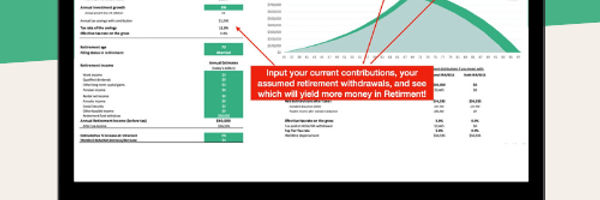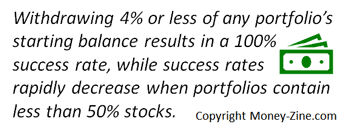When it comes to withdrawal rates from a retirement account, the rule of thumb is 4% of the starting balance without fear of depleting the account. This rule of thumb has been around for quite some time, and many individuals might be wondering if these old rules still apply today. Using the correct rate is important, because the retiree needs to balance the risk of running out of money with living too frugally in retirement. In this article, we're going to help answer the question: How much can I withdraw from my retirement account each year? That answer will apply to all types of retirement accounts, including Roth IRAs, 401(k) plans, Traditional IRAs as well as 403(b) plans. As part of that discussion, we'll explain how it's possible to calculate an appropriate withdrawal rate based on 84 years of historical data. Then we'll use two examples to illustrate this point. Finally, we'll explain why it's important to make adjustments to any plan, and the pitfalls of blindly sticking to a plan.

Roth IRA or 401k? This template will answer your questions.
With this template, you will get:
All DFY, simply add your details
Charts for comparison and clear answer
Easily update for any year (2023, 2024, 2025, etc…)

Income in Retirement
Additional Resources |
One of the biggest financial challenges individuals face is retirement. After all, a very reasonable planning assumption is to put money in a retirement account for 40 years, and then live comfortably off that savings for another 30. The federal government understands how challenging this will be to individuals, and provides taxpayers with incentives to save money into retirement accounts. When everyone was working, it was easy to understand how much money was available to spend each month. But when retired, it's not easy to understand how much money can be withdrawn from an account. The retiree needs to balance the desire to live comfortably in the short term with the risk of outliving the money in their retirement portfolio. For many individuals, knowing how much to spend each year is critical.
Account Withdrawal Rates
Fortunately, answering this question has been the subject of many scholarly studies. Perhaps the most important work in this area has been conducted by Philip L. Cooley, Ph.D.; Carl M. Hubbard, Ph.D.; and Daniel T. Walz, Ph.D while at Trinity University. In their 2011 publication, Portfolio Success Rates: Where to Draw the Line, these professors refresh an earlier study published back in 1998. This body of work attempts to predict the success rate of an investment portfolio, with success being defined as the likelihood that money in the retirement portfolio would outlive the retiree. Using rolling periods of 15, 20, 25, and 30 years from 1926 through 2009, these scholars were able to provide a theoretical success rate based on two inputs: the retirement portfolio's mix of stocks and bonds, and the desired payout period. Using these two factors, the study provides insights into the portfolio's success at withdrawal rates ranging from 3 to 12% of the account balance.

Summarizing some of the insights derived from that study:
Withdrawing 4% or less of any portfolio's starting balance results in a 100% success rate with payout periods up to 30 years.
A 7% withdrawal rate from a retirement portfolio consisting of 75% stocks and 25% bonds provides a success rate of 91% with a payout period of 30 years.
Success rates rapidly decrease when portfolios contain more than 50% bonds (or less than 50% stocks).
Over relatively short periods of time (15 years), the likelihood of success increases as the percentage of stocks held in a portfolio increases.
Inflation and Purchasing Power
Finally, the study acknowledges the fact inflation decreases the purchasing power of a dollar over time. Using a well known measure of inflation, the Consumer Price Index for an urban consumer (CPI-U), the study also predicted success when the initial withdrawal rate was indexed for inflation annually.
Calculating Withdrawal Rates
To gain a better understanding of the results of this landmark study, we've put together a Withdrawal Rate Calculator. This tool allows the investor to rapidly compare the success rates of a retirement portfolio using a variety of "what if" scenarios, avoiding the necessity of learning how to apply complex mathematical equations to solve this problem. We're going to use the output of that calculator in the examples that follow.
Example 1: Early Retirement
In this first example, Jim is a 62 year old that has just retired with $1 million in his savings accounts. Jim is conservative and believes that as he ages, he will purchase fewer items. Therefore, he does not wish to increase his income for inflation each year. He's comfortable with a portfolio that is 50 % stocks and 50% bonds. He also wants to be 100% certain that his account will provide income for 30 years. The calculator indicates that Jim can withdraw 5% of the starting balance of his retirement portfolio and achieve his goals. This means that Jim can withdraw 5% of $1 million, or $50,000, per year for the next 30 years.
Example 2: Delayed Retirement
In this second example, Sally loved her job and worked until she was 70 years old. She managed to save $750,000 in her retirement accounts, which is 100% invested in stocks. Sally wants to travel in retirement, and doesn't want inflation (2% per year) to erode her purchasing power. She's also willing to assume a 20% risk that her retirement portfolio will not last 20 years. The calculator indicates Sally can withdraw 6% of the starting balance, with adjustments for inflation, with an 80% risk of success. This means Sally can withdraw 6% of $750,000, or $45,000, per year for the next 20 years. Since Sally will be adjusting her withdrawals for inflation (2%), she will withdraw $45,000 x 1.02 or $45,900 in year 2, and $45,900 x 1.02 or $46,818 in year three... and so on.
Economic Impact on Withdrawals
Financial conditions will change over time. During the course of a 30 year timeframe, the retiree may be faced with multiple bear markets and economic downturns. For this reason, it's important to reassess withdrawal rates as those conditions change. The work of Cooley, Hubbard, and Walz examined stock and bond market returns over a relatively long period of time, one that certainly experienced a number of significant market downturns. This team also believed in ongoing portfolio management. That is to say, they advocate the retiree actively reassess their withdrawal rate plans during extraordinary economic and financial events. When they occur, retirees have little choice but to lower the rate or risk depleting their portfolios prematurely. This is especially true when success rates approach 75%. It's reasonable to conclude the need to reassess these plans at least once every five years. Since the study published success rates at five year increments, it is easy for the retirement planner to determine an acceptable withdrawal rate given the new or emerging market conditions.
About the Author - Determining Retirement Withdrawal Rates



.jpg)
.jpg)